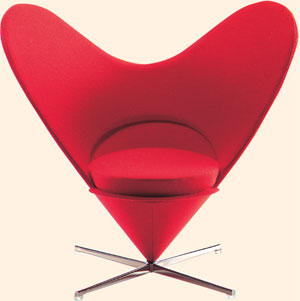Design classic: The Heart Cone chair by Verner Panton

Simply sign up to the Life & Arts myFT Digest -- delivered directly to your inbox.
Unlike his Danish contemporaries, who created simple wooden furniture, Verner Panton (1926-1998) made his name with futuristic pop art designs.
During the 1950s, Danish design was at its peak. Designers such as Arne Jacobsen and Hans Wegner worked in wood, refining and modernising traditional techniques, whereas Panton was more interested in innovation and pushing boundaries. He made the first inflatable furniture and experimented with plastics to create curves and strong geometric shapes in bright colours.
“The main purpose of my work is to provoke people into using their imagination,” he said. “Most people spend their lives living in dreary, grey-beige conformity, mortally afraid of using colours. I try to show new ways, to encourage people to use their fantasy imagination and make their surroundings more exciting.”
Although Panton’s most famous piece is the plastic curved S chair, the Heart Cone chair is perhaps his most striking. First produced in 1959, it was a successor to the Cone, which he had designed the previous year for his parents’ restaurant in what was his first major commission. The Cone was admired by a customer who offered to put it into production. When it was subsequently photographed for Mobila magazine draped with naked models, there was a minor scandal but the resulting publicity did Panton’s career no harm.
The Cone chair was later taken to New York where police ordered it to be removed from a Fifth Avenue shop window because it was attracting crowds.
In the 1960s, Panton began a longstanding partnership with Vitra, which still produces his designs today. The company’s brochure describes the Heart Cone chair, with its Mickey Mouse ears, as a contemporary version of a traditional wingback chair.
His work fell out of favour during the 1970s, but during the 1990s Panton looked to revive the Heart Cone chair. The original cross-shaped foot was replaced with a round plate and a leather option was added. The two halves of the heart were also made slightly narrower. He continued to experiment with colour and materials until his death in 1998, designing the multicoloured Vilbert chair for Ikea in 1993. He died 12 days before a retrospective of his work was due to open at the Trapholt Museum in Kolding, Denmark.
Comments